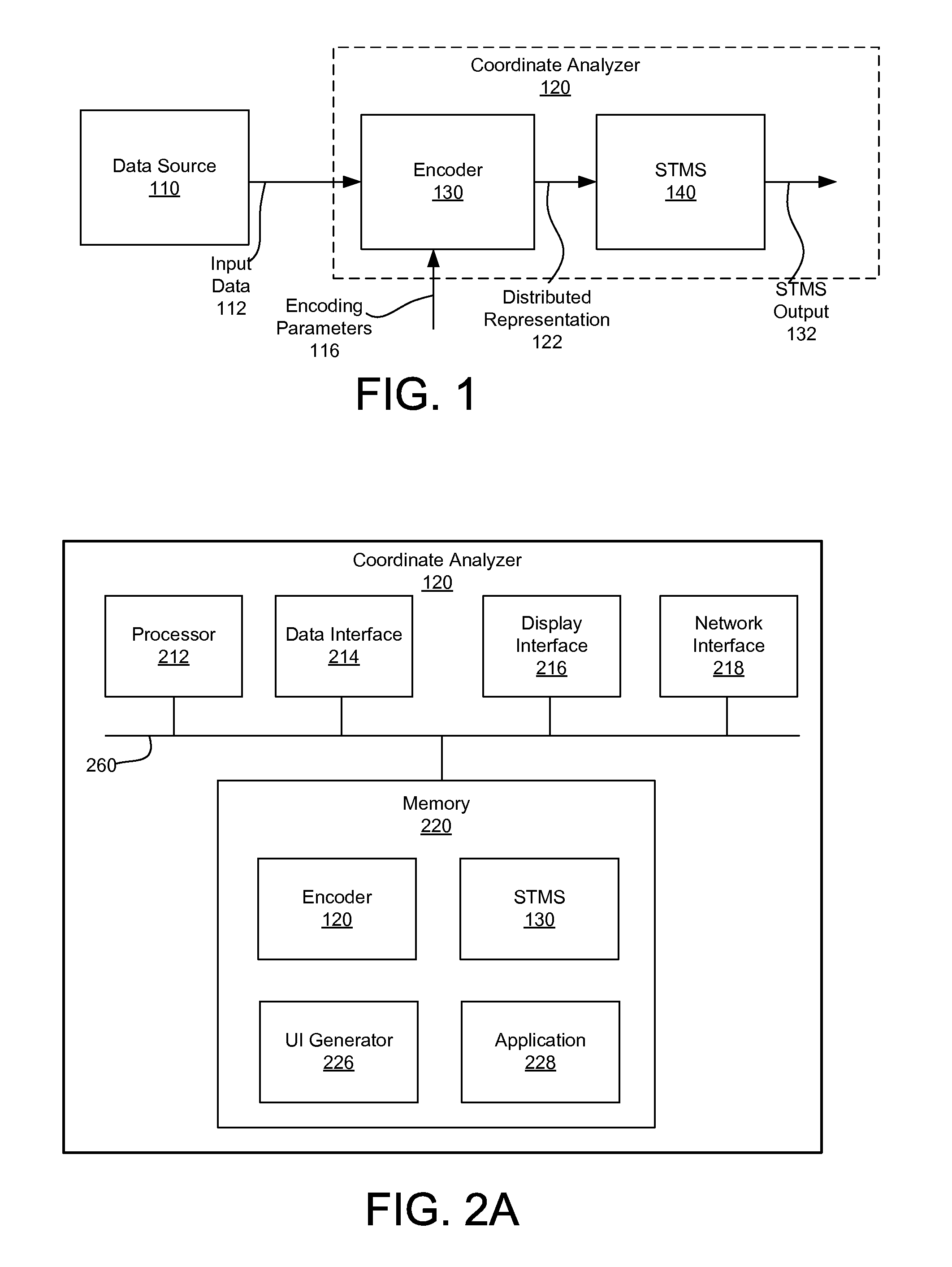Sparse distributed representation of spatial-temporal data
- Summary
- Abstract
- Description
- Claims
- Application Information
AI Technical Summary
Benefits of technology
Problems solved by technology
Method used
Image
Examples
example stms
[0031]FIG. 1 is a conceptual diagram illustrating relationships between a data source 110, an encoder 130, and a STMS module 140, according to one embodiment. The encoder 130 and STMS module 140 are included in a coordinate analyzer 120 that evaluates input data 112 from the data source 110. Although one of each component is illustrated, various embodiments may include multiple instances of components (e.g., multiple data sources 110, multiple STMS modules 140).
[0032]The data source 110 may be any source outputting input data 112 that may be encoded for processing by an STMS. Typically, data sources 110 output one or more dimensions of input data 112, which vary with time. The one or more dimensions of input data 112 may be converted to a coordinate encoded as a distributed representation. Example data sources 110 include (i) a usage monitor of a webserver (e.g., physical, cloud, virtual) outputting input data 112 such as page loads, downloads, uploads, purchases, or clicks; (ii) a ...
example regions
Around an Input Coordinate
[0065]FIGS. 4A through 4D are conceptual diagrams of example regions 406 around an input coordinate 402, according to various embodiments. The input coordinate is illustrated in an array 400 of discrete coordinates. A region includes an input coordinate 402 and neighbor coordinates. A subset of neighbor coordinates 410 are selected and hashed to determine which elements of the distributed representation are active. Although illustrated with respect to two-dimensional input data, other input data having three or more dimensions may have corresponding regions encompassing three or more dimensions, and other input data having one dimension may have corresponding one-dimensional ranges, as described further with respect to FIG. 6.
[0066]FIG. 4A illustrates a square region 406. FIG. 4B illustrates a circular region 416. The side length of the square region 406 and the radius of the circular region 416 may be determined by an aggregate measure of change (e.g., spe...
example detection
of Anomalies from Input Coordinates
[0070]FIGS. 5A through 5D are conceptual diagrams illustrating detection of anomalies from input coordinates, according to one embodiment. Although described with respect to an application 228 monitoring movement of a delivery truck for anomalies, other input data 112 may be used or may be analyzed differently.
[0071]FIG. 5A illustrates a habitual path 506 across geographic locations traveled by a truck on a delivery route. As the truck travels, a location sensor reports input coordinates 502. The encoder 120 converts the input coordinates 502 to distributed representations provided to the STMS module 130. Repeated exposures to the input coordinates trains the STMS module 130 to recognize the temporal sequence of input coordinates 502 and to predict a next coordinate in the temporal sequence. To detect anomalies, the application 228 compares distributed representations encoding predicted coordinates output by the STMS module 130 to distributed repre...
PUM
 Login to View More
Login to View More Abstract
Description
Claims
Application Information
 Login to View More
Login to View More - R&D
- Intellectual Property
- Life Sciences
- Materials
- Tech Scout
- Unparalleled Data Quality
- Higher Quality Content
- 60% Fewer Hallucinations
Browse by: Latest US Patents, China's latest patents, Technical Efficacy Thesaurus, Application Domain, Technology Topic, Popular Technical Reports.
© 2025 PatSnap. All rights reserved.Legal|Privacy policy|Modern Slavery Act Transparency Statement|Sitemap|About US| Contact US: help@patsnap.com



